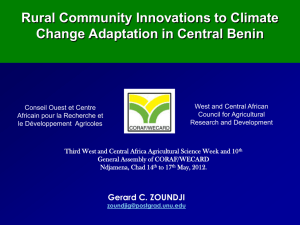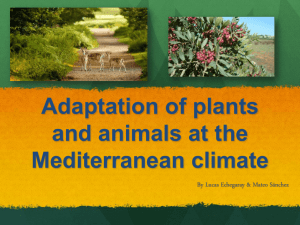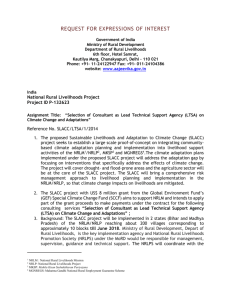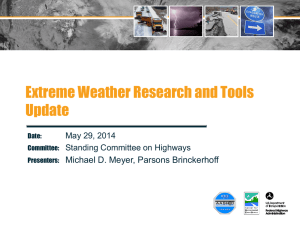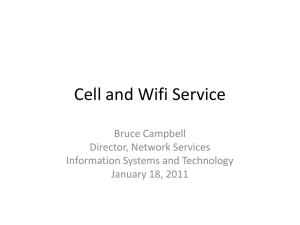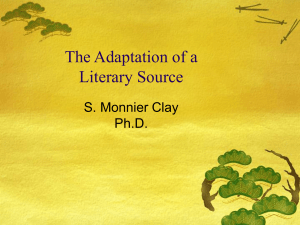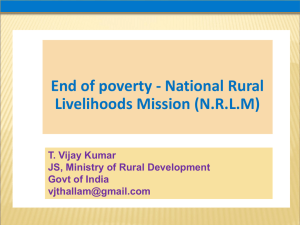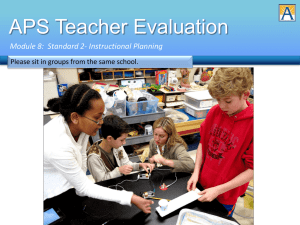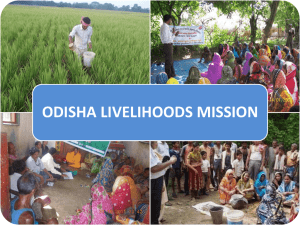Key Messages from WGII AR5 Impacts, adaptation and
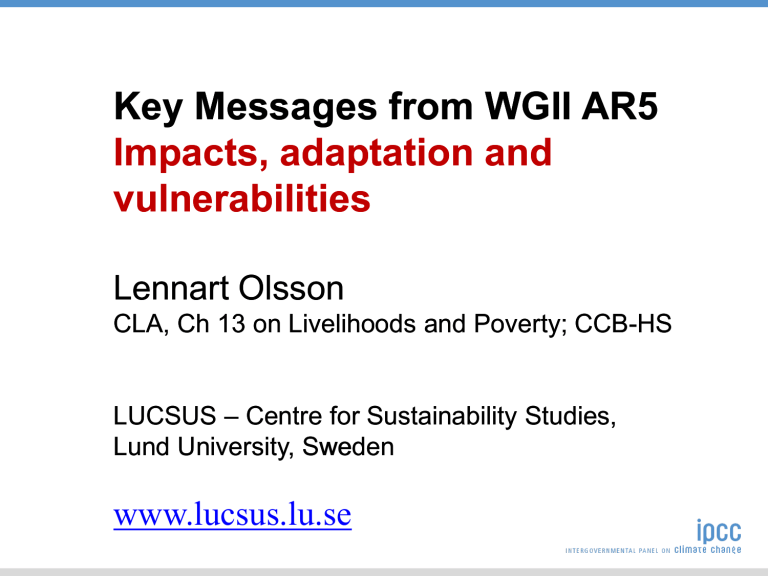
LUCSUS – Centre for Sustainability Studies, www.lucsus.lu.se
1.Key features of AR5 WG II
2.What CC impacts can we see so far
3.What are the risks of future CC – focus SE Europe
4.What can adaption do for us?
AR4 7. Industry, Settlement and Society
8. Human Health
AR5
8. Urban Areas
9. Rural Areas
10. Key Economic Sectors
11. Human Heath
12. Human Security
13. Livelihoods and Poverty
AR4
AR5
17. Assessment of Adaptation Practices, Options, Constraints and Capacity
18. Inter-relationships Between Adaptation and Mitigation
14. Adaptation Needs and Options
15. Adaptation Planning and Implementation
16. Adaptation Opportunities, Constraints, and Limits
17. Economics of Adaptation
1.Key features of AR5 WG II
2.What CC impacts can we see so far
3.What are the risks of future CC – focus SE Europe
4.What can adaption do for us?
Calibrated uncertainty language
M H VH
L M H
VL L M
Mastrandrea M., et al 2010: Guidance note for lead authors of the IPCC fifth assessment report on consistent treatment of uncertainties
According to the WGI, it is very likely that the number and intensity of hot days have increased markedly in the last three decades and virtually certain that this increase will continue into the late 21
st
century. In addition, it is likely that the occurrence of heat waves
(multiple days of hot weather in a row) has more than doubled in some locations, but very likely that there will be more frequent heat waves over most land areas after mid-century.
The Hot Summer of 2010: Redrawing the Temperature Record Map of Europe. Barriopedro 2011 (Science 8 Apirl 2011)
France 2003 (15 000)
Europe 2003 (35 000 -
70 000)
Russia 2010 (55 000)
Brisson, N., 2010: Why are wheat yields stagnating in Europe? A comprehensive data analysis for
France . Field Crops Research 119 201-212
Heat effect Rainfall effect
The critical role of extreme heat for maize production in the United States
David B. Lobell, Graeme L. Hammer, Greg McLean, Carlos Messina, Michael J. Roberts andWolfram Schlenker
NATURE CLIMATE CHANGE, VOL 3, MAY 2013, p 497-501
1.Key features of AR5 WG II
2.What CC impacts can we see so far
3.What are the risks of future CC – focus SE Europe
4.What can adaption do for us?
i) Risk of death, injury, ill-health, or disrupted livelihoods in low-lying coastal zones and small island developing states and other small islands, due to storm surges, coastal flooding, and sea level rise.37 [RFC 1-5] ii) Risk of severe ill-health and disrupted livelihoods for large urban populations due to inland flooding in some regions.38 [RFC 2 and 3] iii) Systemic risks due to extreme weather events leading to breakdown of infrastructure networks and critical services such as electricity, water supply, and health and emergency services.39 [RFC 2-4] iv) Risk of mortality and morbidity during periods of extreme heat, particularly for vulnerable urban populations and those working outdoors in urban or rural areas.40 [RFC 2 and 3] v) Risk of food insecurity and the breakdown of food systems linked to warming, drought, flooding, and precipitation variability and extremes, particularly for poorer populations in urban and rural settings.41 [RFC 2-4] vi) Risk of loss of rural livelihoods and income due to insufficient access to drinking and irrigation water and reduced agricultural productivity, particularly for farmers and pastoralists with minimal capital in semi-arid regions.42 [RFC 2 and 3] vii) Risk of loss of marine and coastal ecosystems , biodiversity, and the ecosystem goods, functions, and services they provide for coastal livelihoods, especially for fishing communities in the tropics and the Arctic.43 [RFC 1, 2, and 4] viii) Risk of loss of terrestrial and inland water ecosystems , biodiversity, and the ecosystem goods, functions, and services they provide for livelihoods.44 [RFC 1, 3, and 4]
EUROPE
Increased Flood
Losses and Impacts
Present
2030-40
2080-2100; 2
°
C
2080-2100; 4
°
C
Increased Water
Restrictions
Very
Low
Risk-Level
Med
Very
High
Risk Level with
High Adaptation
Potential for
Additional
Adaptation to
Reduce Risk
Risk Level with
Current Adaptation
Increased Losses and
Impacts from Extreme
Heat Events very low very high
‘… the frequency of dangerous heat conditions also increases significantly faster and more strongly’
2021-2050 2071-2100
SRES A1B ca RCP6.0
E. M. Fischer and C. Schär: Consistent geographical patterns of changes in high-impact European heatwaves. NATURE GEOSCIENCE JUNE 2010, 398-403
SRES A2, Similar to RCP8.5
SREX [3.5.1, Figure 3-9]
Figure TS.6 | (A) Percentage change of mean annual streamflow for a global mean temperature rise of 2°C above 1980–2010. Color hues show the multi-model mean change across 5 General Circulation Models
(GCMs) and 11 Global Hydrological Models (GHMs), and saturation shows the agreement on the sign of change across all 55 GHM–GCM combinations (percentage of model runs agreeing on the sign of change).
• mid Pliocene (3.3 – 3.0 ma), 1.9 – 3.3 °C , 350-45 ppm CO
2
: up to +20 m GSL
• Last interglacial (129 – 116 ka), about +2 °C:
+5-10 m GSL °C
• 1901 – 2010: 1.7 mm/year; 1993 – 2010: 3.2 mm/year
TFE.2, Figure 2 | Compilation of paleo sealevel data (purple), tide gauge data (blue, red and green), altimeter data (light blue) and central estimates and likely ranges for projections of global mean sea level rise from the combination of CMIP5 and process-based models for RCP2.6
(blue) and RCP8.5 (red) scenarios, all relative to pre-industrial values. {Figures 13.3, 13.11, 13.27}
1.Key features of AR5 WG II
2.What CC impacts can we see so far
3.What are the risks of future CC – focus SE Europe
4.What can adaption do for us?
Adaptation is place- and context-specific, with no single approach for reducing risks appropriate across all settings!
Key Messages from WGII AR5
Impacts, adaptation and vulnerabilities
Lennart Olsson
CLA, Ch 13 on Livelihoods and Poverty; CCB-HS
LUCSUS – Centre for Sustainability Studies,
Lund University, Sweden www.lucsus.lu.se
Peters, Marland etal 2011
IPCC AR5 WGIII, SPM


